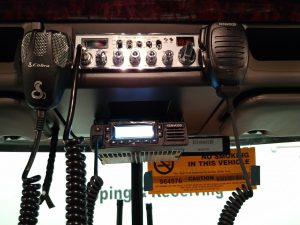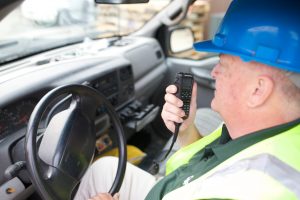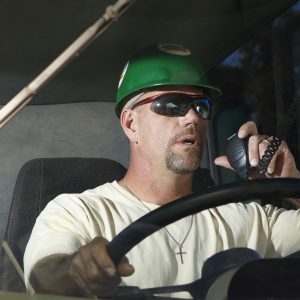Alberta’s distracted driving laws are strict and increasingly comprehensive. While there are exceptions for hands-free calls and emergency communications, the list of prohibited activities is long. Just take a look at this excerpt:
- talking on a hand-held cell phone
- texting/e-mailing
- using electronic devices like laptop computers, video games, cameras, video entertainment displays and programming portable audio players (e.g., mp3 players)
- manually entering information on GPS units
- reading printed material like a book or a magazine
- writing, printing or sketching
- personal grooming like combing your hair, applying makeup or brushing your teeth
Alberta’s legislation does make exceptions for the use of two-way radios when drivers are behind the wheel, and with good reason. Drivers may be responding to emergencies, transporting children on a school bus, coordinating the movement of oversized loads through a city. For those activities, communication is critical to doing the job safely. Here are those exceptions, just to give you an idea:
“Using 2-way radios or hand-held radios, such as those commonly referred to as CB (Citizen’s Band) radios, when escorting oversized vehicles, to contact one’s employer, or when participating in search, rescue, and emergency management situations.”
This exception in the legislation extends to hands-free, two-way radio use as well. So, if yours is a team that is constantly on the move, be it in buses driving to the Fort McMurray Oil Sands or delivery vans moving around the Edmonton area, two-way radios can be used to keep them connected to each other and dispatchers while staying within the bounds of the law.
Equipping your fleet with mobile two-way radios will give your drivers the ability to conduct work-related communication within the bounds of the law. More importantly, it will allow them to communicate with dispatchers and fellow drivers so they can get the job done safely and efficiently.
Implementing In-Vehicle Radio Solutions
Setting your fleet up with two-way radios is a relatively simple process. You need:
The Radio Itself
Mobile radios, as opposed to the portable (handheld) variety, are a good fit for most vehicles, with exceptions being vehicles like forklifts. They can be installed in your fleet vehicles, be it in your console, below your CB radio or in a custom location specified by your driver or fleet manager. If you’re going to rent your mobile radio, your radio can be mounted in a seat rack that can be easily removed. Fleet managers often prefer the seat mounts because they are less invasive.
A Speaker Mic
If you’ve used a two-way radio (mobile or portable) before, you’re already familiar with this type of gear. It’s a radio accessory that, in the case of mobiles, allows you to transmit and receive messages. Although it is technically a handheld device, drivers can use their speaker mic and still be within the bounds of Alberta’s distracted driving legislation.
A Control Head
A control head isn’t, strictly speaking, necessary, but it can make operating a mobile radio much easier, especially if your drivers use gloves or drive vehicles with crowded cabins.
A control head is an accessory that effectively replicates the display and controls that are present on the face of your two-way radio. Some are designed with larger buttons so that drivers who wear gloves – like firefighters or forestry workers – can use the controls without taking off their gloves. Their compact design also allows for a more flexible installation. If, for example, there is insufficient room on the console to install a mobile radio, the radio can be installed elsewhere (like behind the seat) and the control head can be mounted to the console. The two devices are connected by a cable and the driver uses the radio as he ordinarily would.
Watch this video from Motorola Solutions for more detail.
Programming and Frequency Licensing
We’ve talked about the need for frequency licensing in a previous blog, so feel free to give it a look if you want some more details. But, in a nutshell, most frequencies on Canada’s RF spectrum are regulated by Canada’s federal government. Obtaining a license ensures you’ll have private, uninterrupted access to the spectrum for your communications. It also means you’ll avoid hefty fines.
As for programming, it will help you keep your communications organized, allowing for one-to-one communication, one-to-many, or one-to-all if a manager or dispatcher needs it.
Getting Started
The penalties that come from violating distracted driving legislation can cost your business money ($287.00 per offense) and if a driver racks up too many points (3 demerits per offense) it can cost you manpower, too. And, while pulling over in a designated area to conduct a conversation is the safest option, your timetable may not allow for that kind of delay.
Two-way radios are meant strictly for business or operation-oriented communications, not personal calls. That is one reason why using them has been exempted from the list of prohibited activities.
If you have any questions about using mobile two-way radios, or how Alberta’s distracted driving laws could impact your business, Contact Us. Our Account Managers and Service Technicians have been supporting fleets around the province for years, and they’re here to help.
Tridon is a full solution Telecom Systems Integrator with CSA certification and licensed by APEGA. Our Engineering, Service and Tower Divisions collaborate with customers to build engineered solutions including communications systems design, tower inspections and co-location, wireless broadband, fiber optic cabling, site security, and two-way radio communication.







